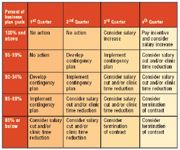Article
How we prod low producers
This clinic came up with a system that spurs subpar performers to make needed changes.
At our Family Medicine Clinic, (four full-time doctors, two part-timers, and one NP), we've always kept our eye on the bottom line. And while it was relatively easy to create an incentive program to encourage our doctors to exceed their economic goals, we've had difficulty dealing with underperformers. In short, the incentive program was our "carrot," but we didn't have a "stick."
Actually, that's not completely true, since we'd always been willing to let underachievers go. But firing is a radical and unpleasant solution, and it's very disruptive to patient care. So, as the group's medical director, I challenged our administrator, Jason Pitts, to come up with a plan that would help us push underperformers to achieve their expected economic goals.
The system Jason came up with is pictured in the grid on the opposite page. It lays out specific levels of economic achievement, and suggests an appropriate action for each level. For example, if a physician is meeting less than 90 percent of his projected goal by the end of the first quarter, the grid calls for the implementation of a contingency plan designed to bring him up to where he should be. We track progress-or lack thereof-throughout the year. Those who remain considerably below their projected goals might be subject to a salary cut and/or a comparable reduction in clinic hours.
Before implementing the system I was tempted to simply present this new system to our physicians, hoping for an immediate improvement in their performance. But Jason said it wasn't that simple. As he explained, the purpose of this plan was to improve current behavior-not to focus on failures. After all, if a physician were billing 85 percent of his monthly goal, it would be easier to help him achieve the remaining 15 percent than trying to start over from scratch.
So, before implementing the new program, Jason suggested three steps to make it more effective:
Based on these suggestions, we added a section to our employment contract that not only explains our incentive program, but also our new intervention plan for subpar performance. We wanted our physicians to know up front what to expect when they exceeded or fell behind their economic goals. At first there was some resentment to the new plan, but our doctors gradually realized that it was designed to assure the success of the entire clinic, not just one or two of its members.
Creating a monthly report to show where each physician stands regarding his economic goals was fairly easy since we have a computerized billing system. We simply run a report for each physician each month. It lists actual billings and the billings needed to meet his or her goal. For those who exceed their goals, the monthly report provides positive feedback, assuring them that they're on track to receive an incentive bonus. For those who aren't achieving their goals, the report gives them an opportunity to correct their performance before the next quarterly review.

For physicians who fall behind their quarterly goals, the system's contingency plan suggests several methods for improvement: shortening appointment times to accommodate more patient visits; changing work days or hours to see more patients; working longer on Friday or Monday, when there tend to be more acute visits.





